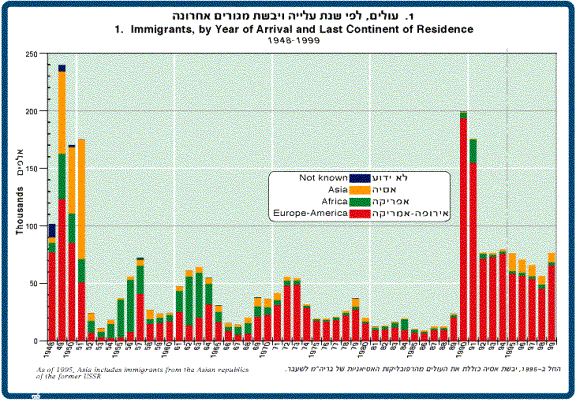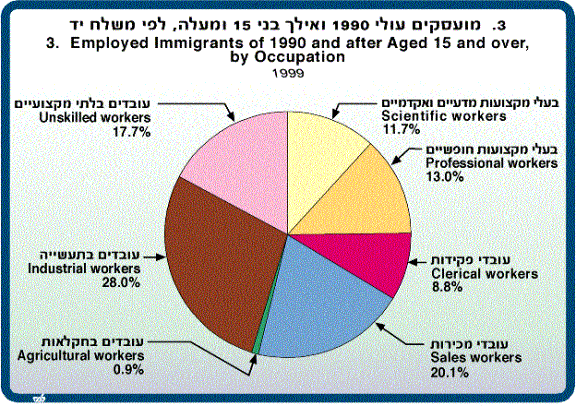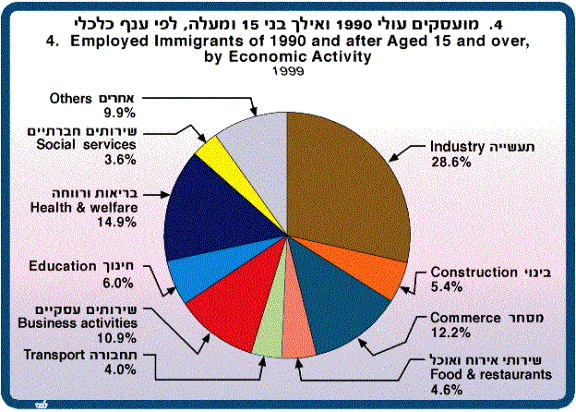
Immigration in Israel
| Concept | Detail | Comments |
| Overview | Summary of Immigration phenomenon in Israel. Special attention to the 1990s wave of immigration | |
| Main information resources |
Ministry of Immigrant Absorption
|
|
| Charts and Tables | Power Point presentation on immigration Statistics | Basic source is MIA |
Overview
on Immigration in Israel (1990-2000)
1. Israel, country of immigrants
Israel started to exist as a country in 1948 (although it was formally recognized as such by the UN in 19?). Therefore, immigrants form a big part of their population (%).
As can be seen in the graph below, there have been two distinct immigration waves. The first one took place in 1950 when the country started to exist as such. The second started in 1990 due to the disintegration of the Soviet Union.

2. Several important characteristics of this second wave are:
a. Its size.
Between 1990 and 1998 900.000 immigrants have entered the country. This is, 16% of the actual population
b. Its speed.
450.000 of this immigrants arrived in Israel between 1990 and 1992. Structural adjustments to absorb this flow of population were huge and not always smooth. As can be seen in the Power Point presentation, the unemployment gap between immigrants and the rest of the population was not closed until 1995.
c. Its composition
85% of the new immigrants came from the former Soviet Union. Of these almost 1/3 came from Russia and 1/3 from Ukraine.
3.
Characteristics of the 1990s wave
a.
Age
Between 50 and 60% of the soviet immigrants that arrived in Israel after 1990 were in working age
b.
Skill level
11% of the immigrants were engineers, 5% teachers and another 7% were physicians, artists, etc. This means that at least 50 to 60% of the immigrants in working age were skilled professionals.
c.
Occupation

d.
Economic Activity

4.
Mechanisms of Absorption
It
is already significant that Israel has a Ministry of immigration absorption (I
don?t know if it was created before 1990)
As
a consequence of the second wave of immigration, robust absorption mechanisms
were set in place. The basic services offered to immigrants deal with Housing,
education, documentation? but most importantly for this study is the fact that,
from the beginning, the following units and programs had a considerable weight:
Center
for Absorption in Science
Claims that more than 13.000 scientists are registered at CAS and an annual flow of 750 is expected. Of these, only 75% seem to be employed. Although data provided by the center is a little confusing, it seems that ½ of those scientists working, do so in private firms. Another ¼ works at universities. The most important programs of this center are named Giladi and Kamaeya (see more info on this programs in PP presentation)
Entrepreneurship Unit
Through the Bashan program, this unit is stimulating and supporting talented immigrants to create their own companies. (more info on Bashan in PP presentation). It is important to mention that this group has nothing to do with the tech incubators program. Tech incubators depend on the Office of the Chief Scientist (Ministry of industry).
REASONABLE
CONCLUSIONS at this point
The second wave of immigration must have had an important role in the shape of today’s Israeli population structure and pool of intellectual capital.
Strong governmental mechanisms for absorption were set in place in the early 1990s. The importance of attracting and retaining high skilled people was explicit from the very beginning and resources were mobilized to facilitate their integration in Israel.
Although the Ministry of Immigration and Absorption had a crucial role in attracting and retaining Soviet scientists, the ministry of industry also set in motion programs that helped capture this intellectual capital and put it to work in high tech oriented activities (some surveys indicate that up to 70% of tech incubators companies employees are immigrants)
-
What do they consider a scientist?
-
What fields of expertise did these scientists have?
-
In what fields or industries are they employed?
-
What has been their impact in the tech growth of Israel? And in the
software
sector? As technicians or as entrepreneurs?
-
There are still 1 Million Jewish soviets eligible for immigration to
Israel;
have the best already emigrated?